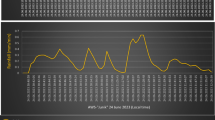Abstract
Super-parameterization (SP) aims to explicitly represent deep convection within a coarse resolution global model by embedding a cloud resolving model (CRM) in each column of the mother model. For the first time, we implemented the SP in a mesoscale regional weather model, the Global/Regional Assimilation and PrEdiction System (GRAPES). The constructed SP-GRAPES uses a two-dimensional (2D) CRM in each grid column. A control and two SP simulations are conducted for the Beijing “7.21” heavy rainfall event to evaluate improvements in GRAPES using SP. The SP-run-I is a basic SP run delivering microphysics feedback only, whereas the SP-run-II delivers both microphysical and cloud fraction feedbacks. A comparison of the runs indicates that the SP-run-I has a slightly positive impact on the precipitation forecast than the control run. However, the inclusion of cloud fraction feedback leads to an evident overall improvement, particularly in terms of cloud fraction and 24-h cumulative precipitation. Although this is only a preliminary study using SP-GRAPES, we believe that it will provide considerable guidance for follow-up studies using SP in China.
Similar content being viewed by others
References
Arakawa A., 2004: The cumulus parameterization problem: Past, present, and future. J. Climate, 17, 2493–2525.
Arakawa A., and V. R. Lamb, 1981: A potential enstrophy and energy conserving scheme for the shallow water equations. Mon. Wea. Rev., 109, 18–36.
Charney J. G., and N. A. Phillips, 1953: Numerical integration of the quasi-geostrophic equations for barotropic and simple baroclinic flows. J. Meteor., 10, 71–99.
Chen Dehui, Xue Jishan, Yang Xuesheng, et al., 2008: The overall design of the new generation global/regional multi-scale unified numerical weather prediction system GRAPES. Chin. Sci. Bull., 53, 2396–2407.
Durran D. R., and J. B. Klemp, 1983: A compressible model for the simulation of moist mountain waves. Mon. Wea. Rev., 111, 2341–2361.
Grabowski W. W., 2001: Coupling cloud processes with the large-scale dynamics using the cloud-resolving convection parameterization (CRCP). J. Atmos. Sci., 58, 978–997.
Grabowski W. W., 2003: Impact of cloud microphysics on convective-radiative quasi equilibrium revealed by cloud-resolving convection parameterization. J. Climate, 16, 3463–3475.
Grabowski W. W., 2006: Impact of explicit atmosphereocean coupling on MJO-like coherent structures in idealized Aqua Planet simulations. J. Atmos. Sci., 63, 2289–2306.
Grabowski W. W., and P. K. Smolarkiewicz, 1999: CRCP: A cloud resolving convection parameterization for modeling the tropical convecting atmosphere. Physica D: Nonlinear Phenomena, 133, 171–178.
Hong, S.-Y., J. Dudhia, and S.-H. Chen, 2004: A revised approach to ice microphysical processes for the bulk parameterization of clouds and precipitation. Mon. Wea. Rev., 132, 103–120.
Hong, S.-Y., and J.-O. J. Lim, 2006: The WRF singlemoment 6-class microphysics scheme (WSM6). J. Korean Meteo., 42, 129–151.
Jung, J.-H., and A. Arakawa, 2005: Preliminary tests of multiscale modeling with a two-dimensional framework: Sensitivity to coupling methods. Mon. Wea. Rev., 133, 649–662.
Khairoutdinov M., D. Randall, and C. DeMott, 2005: Simulations of the atmospheric general circulation using a cloud-resolving model as a super parameterization of physical processes. J. Atmos. Sci., 62, 2136–2154.
Khairoutdinov M. F., and D. A. Randall, 2001: A cloud resolving model as a cloud parameterization in the NCAR community climate system model: Preliminary results. Geophys. Res. Lett., 28, 3617–3620.
Lim, J.-O.J., and S.-Y. Hong, 2005: Effects of bulk ice microphysics on the simulated monsoonal precipitation over East Asia. J. Geophys. Res., 110, doi: 10.1029/2005JD006166.
Moncrieff M. W., 2004: Analytic representation of the large-scale organization of tropical convection. J. Atmos. Sci., 61, 1521–1538.
Ran Lingkun, Qi Yanbin, and Hao Shouchang, 2014: Analysis and forecasting of heavy rainfall case on 21 July 2012 with dynamical parameters. Chinese J. Atmos. Sci., 38, 83–100. (in Chinese)
Randall D., M. Khairoutdinov, A. Arakawa, et al., 2003: Breaking the cloud parameterization deadlock. Bull. Amer. Meteor. Soc., 84, 1547–1564.
Shen Tongli, Tian Yongxiang, Ge Xiaozhen, et al., 2006: Numerical Weather Prediction. 2nd ed., China Meteorological Press, 431–432.
Skamarock W. C., J. B. Klemp, M. G. Duda, et al., 2012: A multiscale nonhydrostatic atmospheric model using centroidal voronoi tesselations and C-grid staggering. Mon. Wea. Rev., 140, 3090–3105.
Sun Jianhua, Zhao Sixiong, Fu Shenming, et al., 2013: Multi-scale characteristics of record heavy rainfall over Beijing area on July 21,2012. Chinese J. Atmos. Sci., 37, 705–718. (in Chinese)
Wang Bizheng, Liu Min, and Zeng Qingcun, 2005: Study on cloud system superparameterization and the method of characteristic lines in the atmospheric general circulation model. Climatic Environ. Res., 10, 638–648. (in Chinese)
Wicker L. J., and W. C. Skamarock, 2002: Timespliting methods for elastic models using forward time schemes. Mon. Wea. Rev., 130, 2088–2097.
Xu Guoqiang, Chen Dehui, Zhang Hongliang, et al., 2010: The impacts of time-level computation precision ofphysics in the GRAPES model on precipitation prediction. Chinese J. Atmos. Sci., 34, 875–881. (in Chinese)
Xu Guoqiang, Chen Dehui, Xue Jishan, et al., 2008: The optimization experiment and program design of GRAPES physical processes. Chin. Sci. Bull., 53, 2328–2434. (in Chinese)
Xue Jishan and Chen Dehui, 2008: The Scientific Design and Application of Numerical Weather Prediction System GRAPES. Science Press,137. (in Chinese)
Zheng Xiaohui, Xu Guoqing, and Wei Rongqing, 2013: Introducing and influence testing of the new cloud fraction scheme in the GRAPES. Chinese J. Meteor., 39, 57–66. (in Chinese)
Zhu H., H. Hendon, and C. Jakob, 2009: Convection in a parameterized and superparameterized model and its role in the representation of the MJO. J. Atmos. Sci., 66, 2796–2811.
Author information
Authors and Affiliations
Corresponding author
Additional information
Supported by the National Natural Science Foundation of China (41275104), National (Key) Basic Research and Development (973) Program of China (2013CB430106), and National Science and Technology Support Program of China (2012BAC22B02).
Rights and permissions
About this article
Cite this article
Zhu, F., Xu, G., Zheng, X. et al. Super-parameterization in GRAPES: The construction of SP-GRAPES and associated preliminary results. J Meteorol Res 29, 272–292 (2015). https://doi.org/10.1007/s13351-015-4074-2
Received:
Accepted:
Published:
Issue Date:
DOI: https://doi.org/10.1007/s13351-015-4074-2




